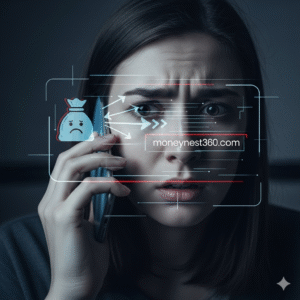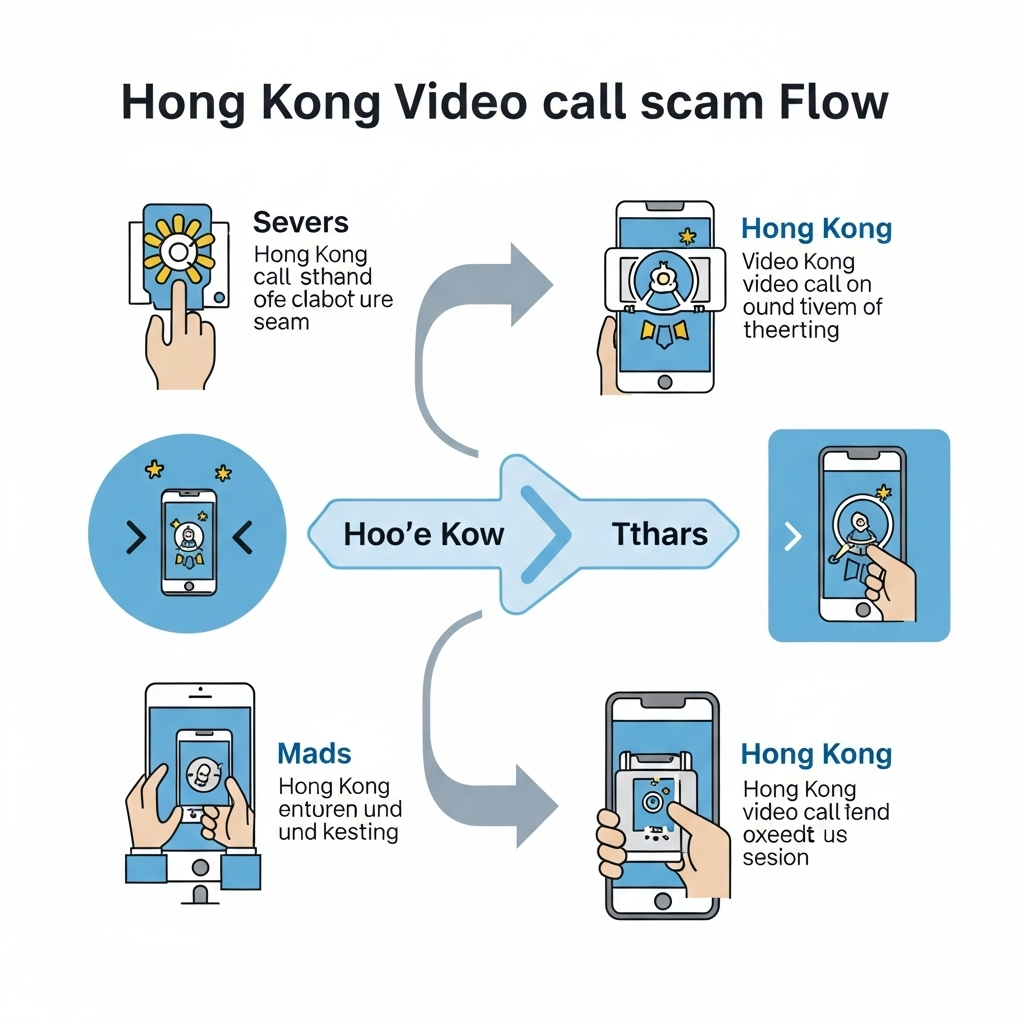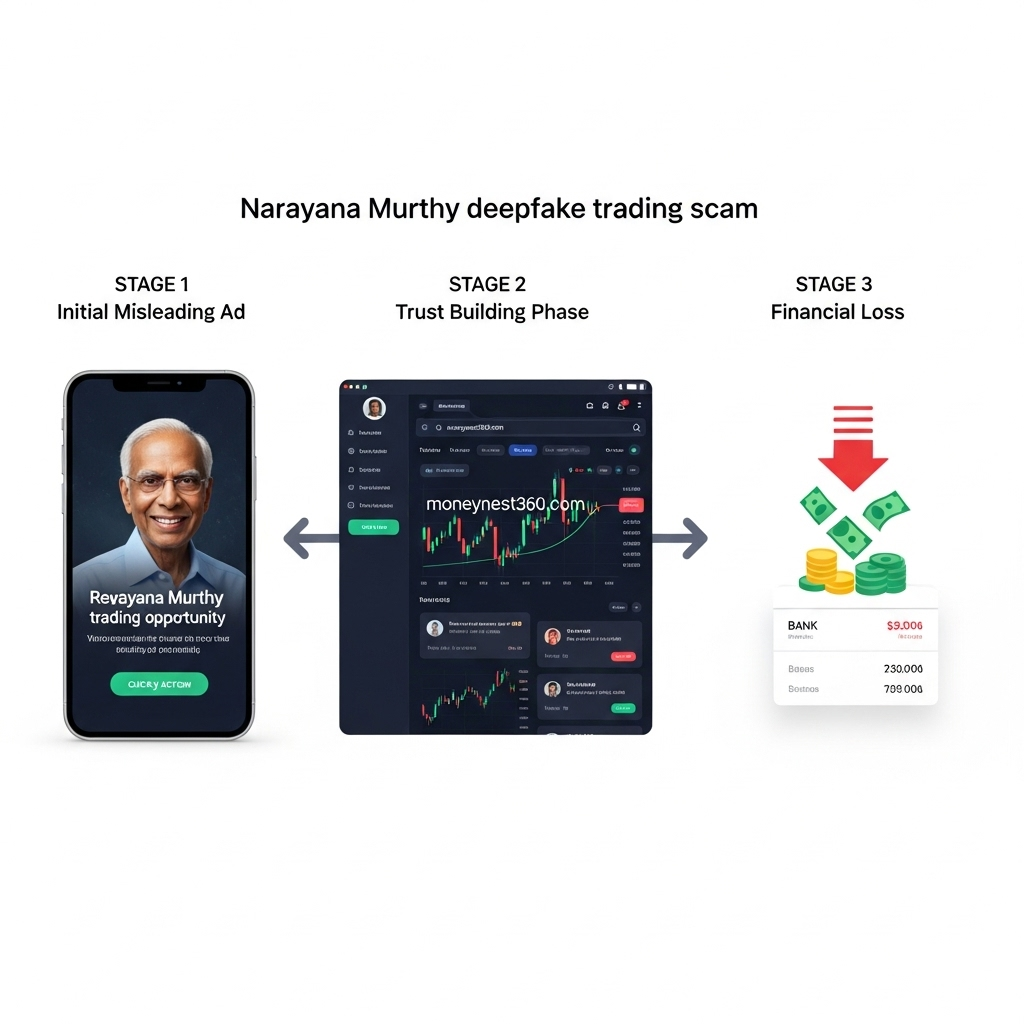In today’s digital world, Artificial Intelligence (AI) is transforming everything – from customer support to financial services. But along with the benefits, cybercriminals are misusing AI to create deepfakes, voice scams, fake videos and phishing attacks that look more real than ever.
If you’re an internet user, it’s crucial to learn how these scams work and how to protect yourself from becoming a victim.
What Are AI Scams and Deepfakes?

AI Scams: Fraudsters use AI-powered tools to mimic voices, generate fake messages, or run phishing schemes. Example: AI-generated voice calls pretending to be your bank representative.
Deepfakes: Hyper-realistic fake videos or audio recordings created using AI. Example: A scammer creating a fake video of a celebrity endorsing an investment scheme.
Common Types of AI Scams You Must Watch Out For
🔊 Voice Cloning Scams
Cybercriminals can now replicate the exact voice of your loved ones or boss within seconds. They call, sound 100% real, and demand urgent money transfers. Many victims send funds without hesitation—only to realize later it was AI-generated fraud.
👉 Real Case: In Florida (2025), a mother received a call from what sounded like her daughter saying she was in an accident. She sent $15,000 – later discovering it was an AI-cloned voice.
🎭 Deepfake Videos & Photos
Hyper-realistic fake videos and images are being used in crypto scams, fake news campaigns, celebrity impersonations, and even political manipulation. If a video seems too shocking or too good to be true, it probably is.
👉 Real Case: In Hong Kong (2024), an employee joined a video call with what looked like his company’s CFO and colleagues. All were deepfakes – and he transferred $25 million to fraudsters.

🤖 AI-Powered Phishing Chatbots
Forget broken English scam emails. Fraudsters now deploy AI chatbots on fake websites that can chat with you in perfect grammar, imitate customer service reps, and trick you into sharing bank details, OTPs, and personal information.
👉 Real Case: Cybersecurity firms have reported phishing chatbots mimicking popular banks’ websites, where victims unknowingly enter login details that go straight to scammers.
💼 Fake Job & Investment Offers
Scammers use AI-generated emails, company websites, and even interview calls to offer unreal salaries or investments. Victims are asked to pay “registration fees” or “security deposits”—and lose their money instantly.
👉 Real Case: In Bengaluru (2025), a 79-year-old woman was tricked by a deepfake video of Narayana Murthy endorsing a trading app. She invested ₹35 lakh and lost everything.

❤️ AI Romance & Relationship Traps
Using AI-generated profile pictures and emotionally intelligent conversations, scammers pretend to be the perfect partner on dating apps. Once trust is built, they start asking for money under emotional or fake emergency pretexts
👉 Real Case: A Los Angeles woman (2025) fell for an AI-powered impersonation of actor Steve Burton. Believing she was in a relationship, she sold property and lost her life savings.
Why Do AI Scams and Deepfakes Succeed?
💡 AI scams are effective because they exploit human psychology and trust, not just technology. Here’s why so many people—even smart professionals—fall victim:
👥 Trust Through Familiarity
Scammers impersonate someone you already trust—a family member, boss, or even a celebrity.
👉 Example: Victims in India received deepfake video calls from “friends” asking for urgent money. The face and voice looked so real that people transferred thousands instantly.
😱 Emotion & Urgency
Fraudsters thrive on panic. They create scenarios like:
- “Your daughter is in an accident”
- “You’ll be arrested if you don’t pay now”
This high-stress, time-sensitive pressure makes victims react emotionally, not logically.
🌐 Misuse of Publicly Available Data
Photos, videos, and even short voice clips from social media are enough to train AI tools. Scammers don’t need hacking skills – your birthday video or LinkedIn speech can be weaponized against you.
📉 Low Technical Awareness
Most people don’t realize how accessible and realistic deepfake tools have become. Scammers rely on this lack of awareness – victims think, “It must be real, because it looks real”.
🚫 Lack of Verification
Victims often don’t double-check through another channel. They trust the first call or video they see.
👉 Example: In the Hong Kong $25 million case, the employee never called the CFO directly to confirm—he trusted the fake video conference.
Also Read: Is Google Gemini 3D Images Safe to Use? What Every Indian Should Know
How to Protect Yourself from AI Scams and Deepfakes
✅ Verify Before Trusting
Never rely on a single call, video, or message – even if it feels real. Always call back using the original number or verify through another trusted channel.
👉 Example: If your boss asks for an urgent transfer on a video call, hang up and call their official office line.
🔐 Enable Multi-Factor Authentication (MFA)
Even if scammers steal your password, MFA adds an extra shield (like OTP, fingerprint, or app code). Always enable it for email, banking, and social media accounts.
👀 Check Video & Audio Carefully
Look for unnatural blinking, mismatched lip movements, robotic tones, or awkward pauses. These are common signs of deepfake manipulation.
👉 Tip: Play the video at slower speed—deepfake glitches often become visible.
🚫 Limit What You Share Publicly
Avoid posting personal data like your phone number, travel plans, or too many candid videos. Scammers use social media photos and audio clips to clone voices or faces.
🌍 Stay Updated with News & Tools
Technology changes fast—so do scams. Use deepfake detection tools like Deepware Scanner and Reality Defender to analyze suspicious videos. Follow cybersecurity news for alerts.
🚨 Report Suspicious Content
If you come across a fake video, cloned voice, or suspicious call, report it immediately on platforms like Facebook, Instagram, and YouTube. This helps stop the spread before others fall victim.
👨👩👧 Educate Family & Friends
Elderly people and kids are the most vulnerable targets. Teach them how scams work, share real cases, and remind them: If something feels urgent and scary online, verify before acting.
Also Read: Meet Your New Money Boss: AI Financial Agents Ready to Run Your Entire Financial Life | Moneynest360
Real Incidents of AI / Deepfake Scams:
1. Hyderabad Homemaker AI Voice-Clone Scam
- What happened: A 72-year-old homemaker in Hyderabad received a WhatsApp message that looked like it was coming from her sister-in-law in New Jersey, urgently asking for money. She called back to confirm, heard the voice, believed it, and transferred money. The Indian Express
- How AI / Deepfake Was Used: Scammers used voice cloning (i.e. mimicking her relative’s voice) to make the plea sound authentic. The Indian Express
- Amount / Impact: ~ ₹1.97 lakh lost.
2.Florida Voice-Cloning “Daughter in Accident” Scam : people.com
- What happened: A woman in Florida received a phone call with what sounded like her daughter’s voice, claiming she’d been in a car crash and was arrested, needing bail. She transferred money. www.ndtv.com
- How AI / Deepfake Was Used: Scammers used only ~15 seconds of her voice from a public appearance to clone her voice, making the scam convincingly real. www.ndtv.com
- Amount / Impact: Almost US $30,000 nearly paid. (The scam was discovered in time before the full amount was lost.) www.ndtv.com
3. “Virtual Arrest” Cyber Fraud in Kollam
- What happened: A 79-year-old man got WhatsApp calls from someone claiming to be BSNL and then “Mumbai Cyber Police”, saying phone number flagged for fraud, presenting fake warrants, threatening arrest. The victim was told they’d be freed under certain conditions, which included transferring money. The Times of India
- How AI / Deepfake Was Used: The perpetrators used video calls (“virtual arrest”), impersonation of officials, plus fake documents, all to create appearance of official/legal authority. While it’s not explicitly stated that voice-cloning was used, the impersonation and video calls rely heavily on deception akin to deepfake style. The Times of India
- Amount / Impact: ₹3.72 crore (across 17 transactions) lost. The Times of India
4. Bengaluru Deepfake Investment Scam using Sadhguru’s Likeness
- What happened: A 57-year-old retired woman from Bengaluru saw what appeared to be a video of spiritual leader Sadhguru Jaggi Vasudev promoting an investment opportunity. The ad promised great returns for a small initial investment. She was later contacted by people posing as instructors/tutors, asking her to invest via stock/trading app, with simulated profits shown to build trust. The Indian Express+2The Financial Express+2
- How AI / Deepfake was used: The video was AI-generated (deepfake) making Sadhguru appear to endorse the firm. Also, voice & image materials were manipulated to resemble something authentic. Scammers set up a fake trading app, used fake testimonials, and carried out the trick via social media reels and WhatsApp. The Indian Express+2The Financial Express+2
- Impact / Amount: The woman lost ₹3.75 crore (~ $450,000-$500,000 depending on conversion) across multiple transactions.
Tools to Protect Yourself from AI Scams & Deepfakes
🔍 Deepfake Detection Tools
- Deepware Scanner – Detects manipulated videos and deepfakes.
- Reality Defender – Browser plugin that flags suspicious videos and media.
- Microsoft Video Authenticator – Analyzes still images and videos to give a confidence score of whether they are manipulated.
- Sensity AI – Enterprise-grade solution for detecting malicious deepfake media online.
🔐 Identity & Security Protection
- Multi-Factor Authentication (MFA) – Use Google Authenticator, Authy, or Microsoft Authenticator to secure accounts.
- Password Managers (1Password, Bitwarden, LastPass) – Protects against phishing by auto-filling only on legitimate sites.
- Caller ID / Call Verification Apps (Truecaller, Hiya) – Can help spot spoofed numbers.
🧠 Awareness & Training
- Cybersecurity News Platforms (KrebsOnSecurity, CyberNews, BleepingComputer) – Stay updated on new scam methods.
- Government Cyber Cells – In India, report fraud at cybercrime.gov.in. In the US, use FTC Report Fraud.
⚡ Pro Tip: No tool is 100% foolproof. The human factor—pausing, verifying, and not rushing—remains the strongest defense.
Top 5 Free Tools to Protect Yourself from AI Scams
- 🔍 Deepware Scanner
- Free tool to check if a video is a deepfake.
- Best for: Verifying suspicious viral videos or forwarded clips.
- 🛡️ Reality Defender (Browser Extension)
- Flags manipulated images, videos, and even AI-generated text.
- Best for: People who browse news, YouTube, or social media often.
- 📱 Truecaller (Free Version)
- Identifies spam/scam calls and protects against voice-cloning fraud.
- Best for: Blocking unknown or spoofed numbers.
- 🔐 Google Authenticator (MFA)
- Adds an extra layer of login security even if your password is stolen.
- Best for: Protecting Gmail, Facebook, Instagram, and banking apps.
- 🔑 Bitwarden (Free Password Manager)
- Creates strong, unique passwords and prevents phishing login attempts.
- Best for: Avoiding fake login pages that scammers set up.
🛡️ “Stay safe, stay smart. Share this guide so others don’t become the next victim of deepfake scams.”
Key Takeaway
Deepfake and AI scams are not futuristic threats—they’re happening right now and costing people millions globally and crores in India. What makes them dangerous is how real and urgent they appear, preying on trust and fear.
But here’s the truth: you have the power to protect yourself.
- Pause before acting on urgent requests.
- Double-verify through another channel.
- Stay updated about new scams.
- Teach your family the same precautions.
Conclusion
AI is transforming our world, but criminals are using the same tools to exploit people. The best defense is awareness, skepticism, and smart digital habits. Don’t trust a face, voice, or video at first glance—verify before you believe.
By spreading awareness and staying alert, we can ensure AI remains a force for progress, not fraud.
⚡ Remember: If it feels too urgent, too emotional, or too good to be true—it probably is.
Frequently Asked Questions (FAQs)
1. What is an AI scam?
An AI scam is a fraud where cybercriminals use artificial intelligence—such as voice cloning, deepfake videos, or AI chatbots—to trick people into giving money, personal details, or access to accounts.
2. How can I spot a deepfake video?
Look for unnatural blinking, mismatched lip-sync, robotic voice tones, strange shadows, or blurred edges around the face. Use free tools like Deepware Scanner or Reality Defender to detect manipulations.
3. What should I do if I receive a suspicious AI-generated call?
- Stay calm.
- Don’t act immediately.
- Hang up and call back the real number of the person or company.
- Report the number as spam on Truecaller or your phone carrier.
4. Are AI scams common in India, Europe, and the USA?
Yes. Global incidents are rising—ranging from deepfake political videos to fake job offers and voice-cloned emergency calls. For example, in Hong Kong, a multinational company lost $25 million to a deepfake video-conference scam.
5. How can I protect my accounts from AI scams?
- Enable Multi-Factor Authentication (MFA) on all accounts.
- Use strong, unique passwords with a password manager like Bitwarden.
- Avoid sharing too much personal info publicly
6. Can deepfakes be completely eliminated?
No. Deepfakes can’t be fully stopped because AI keeps evolving. But awareness, detection tools, and digital hygiene can reduce your risk significantly
7. Who is most at risk of AI scams?
- Elderly people unfamiliar with AI technology.
- Children/teens active on social media.
- Professionals who handle money transfers or sensitive data.








